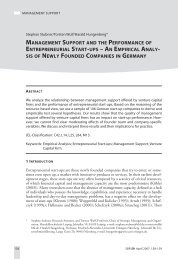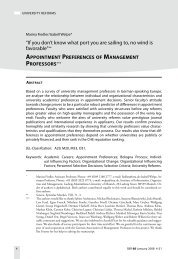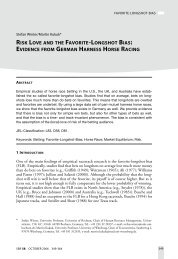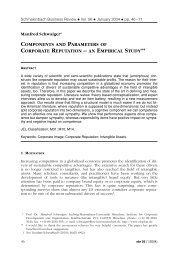“business development”? − the case of biotechnology - sbr ...
“business development”? − the case of biotechnology - sbr ...
“business development”? − the case of biotechnology - sbr ...
You also want an ePaper? Increase the reach of your titles
YUMPU automatically turns print PDFs into web optimized ePapers that Google loves.
S. KIND/D. ZU KNYPHAUSEN-AUFSESS<br />
Our research focus may, second, also be in line with <strong>the</strong> so-called “dynamic capability”<br />
perspective that has recently gained much attention in <strong>the</strong> strategic management literature,<br />
and that seems to have outdated <strong>the</strong> traditional concept <strong>of</strong> strategic planning (see, e.g.,<br />
Amit and Schoemaker (1993); Grant (1996); Teece, Pisano, and Shuen (1997); Winter<br />
(2003)). Indeed, it has been argued, especially in studies on organizational capabilities,<br />
that research has to be very context-specifi c and that we must delve into <strong>the</strong> details to<br />
make <strong>the</strong> concept meaningful (Ethiraj et al. (2005)). If, given <strong>the</strong> present context, we take<br />
skills in molecular biology as a resource that is fundamental to <strong>the</strong> competitive advantage<br />
<strong>of</strong> a <strong>biotechnology</strong> fi rm, <strong>the</strong>n we can understand dynamic capabilities as “<strong>the</strong> antecedent<br />
organizational and strategic routines by which managers alter <strong>the</strong>ir resource base – acquire<br />
and shed resources, integrate <strong>the</strong>m toge<strong>the</strong>r, and recombine <strong>the</strong>m – to generate new valuecreating<br />
strategies” (Eisenhardt and Martin (2001, 1107)). Th us, <strong>the</strong> question is whe<strong>the</strong>r<br />
we can understand <strong>the</strong> BD function as such a dynamic capability.<br />
Eisenhardt und Martin (2001) use diff erent examples to illustrate <strong>the</strong>ir concept; <strong>the</strong> one<br />
that comes closest to BD is strategic decision making, which <strong>the</strong>y defi ne as “a dynamic capability<br />
in which managers pool <strong>the</strong>ir various business, functional, and personal expertise to<br />
make <strong>the</strong> choices that shape <strong>the</strong> major strategic moves <strong>of</strong> <strong>the</strong> fi rm” (Eisenhardt and Martin<br />
(2001, 1107)). In contrast, those researchers who work with <strong>the</strong> concept and who focus on<br />
<strong>biotechnology</strong> fi rms tend to emphasize <strong>the</strong> ability to access and integrate new knowledge<br />
from both within and outside <strong>the</strong> fi rm (Henderson and Cockburn (1994), or <strong>the</strong> ability to<br />
create and maintain alliance relations as at least one core capability, if not <strong>the</strong> sole core capability<br />
<strong>of</strong> <strong>the</strong> fi rm (Deeds, DeCarolis, and Coombs (1998, 1999); Madhok and Osegowitsch<br />
(2000); Rothaermel and Deeds (2006)). Moreover, Kale, Deyer, and Singh (2002) suggest<br />
that precisely this alliance capability only has empirical meaning when we fi nd what <strong>the</strong>y<br />
call a “dedicated alliance function” within <strong>the</strong> fi rm as a device for learning, observing <strong>the</strong><br />
markets, mobilizing internal resources, and systematically evaluating <strong>the</strong> performance <strong>of</strong> alliances.<br />
Obviously, this dedicated alliance function could also be <strong>the</strong> core <strong>of</strong> a BD function in<br />
<strong>biotechnology</strong> fi rms, at least from <strong>the</strong> perspective <strong>of</strong> what we have learned so far.<br />
3 RESEARCH DESIGN<br />
We use a qualitative research design for two reasons. First, <strong>the</strong> research agenda <strong>of</strong> <strong>the</strong> <strong>the</strong>oryas-practice<br />
perspective in general, and our research questions on business development in<br />
particular, call for such an approach, because <strong>the</strong>re is a need for an in-depth understanding<br />
<strong>of</strong> <strong>the</strong> use <strong>of</strong> methods and concepts (practices) that practitioners apply and generate in<br />
<strong>the</strong>ir day-to-day work (praxis) <strong>of</strong> strategizing and organizing (Turner (1994); Whittington<br />
(2002b)). Mintzberg (1973) and Balogun, Huff , and Johnson (2003) argue that access to <strong>the</strong><br />
micro-activities <strong>of</strong> practitioners can only be gained by an ethnographic, or at least contextsensitive,<br />
research design. Such an approach also makes sense because <strong>the</strong> strategy-as-practice<br />
perspective integrates content and process aspects, and <strong>the</strong> latter, as well as <strong>the</strong> dynamic<br />
capability perspective (Ethiraj et al. (2005)), do indeed require a qualitative research design<br />
(Pettigrew (1990); Langley (1999); Johnson, Melin, and Whittington (2003)). Second, since<br />
<strong>the</strong>re are no academic studies available on BD, and since <strong>the</strong> strategy-as-practice perspective<br />
is still in its infancy (Whittington (1996); Johnson, Melin, and Whittigton (2003)),<br />
180 SBR 59 April 2007 176-199






